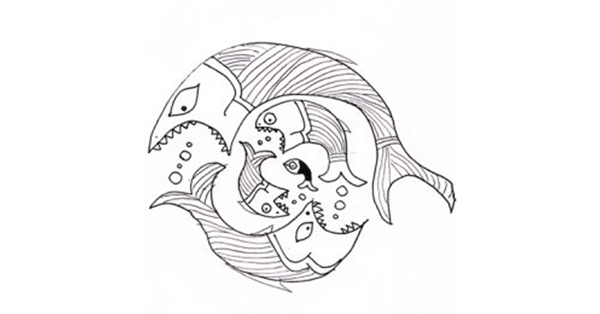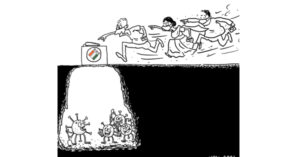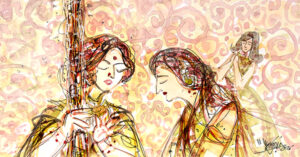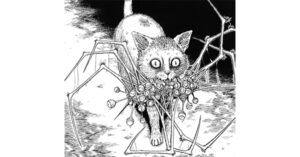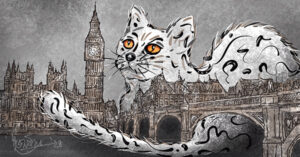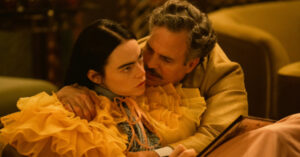In the Shrimad Bhagavatam (1.13.47), composed over a thousand years ago, we find the following verse:
Ahastani sahastanam
apadani catus-padam
phalgani tatra mahatam
jivo jivasya jivanam
‘Those without hands are prey to those with hands
Those without legs are prey to those with four legs
The weak are food for the strong
Life feeds on life‘
This verse observes the ways of the jungle, where might is right. The phrase used for this in ancient Vedic literature is matsya nyaya, or fish justice. This is not supposed to be the way of culture. For humans have the wherewithal to overturn the ways of the jungle.
In culture, the mighty must not feed on the meek; the mighty take care of the meek. This is dharma. When the mighty feed on the meek, when humans behave as animals do, adharma is said to prevail. This is Hindu morality. We find the first glimpse of this idea in the 3,000-year-old Shatapatha Brahmana (11.1.6.24) where the gods establish dharma in the northern direction, which is indicative of stability owing to the presence of the pole star, with waters, which is indicative of fecundity and economic prosperity. “When the waters come, there is abundance and dharma. When the waters do not come, there is scarcity, the mighty prey on the meek, and there is adharma.”
In the 2,500-year-old Brihadaranyaka Upanishad (1.4.11-14), we learn, “A weaker man demands of the stronger man through dharma just as one appeals to the king.” Thus, the king’s role in establishing dharma, and creating an ecosystem where the mighty do not exploit the meek, is established. Rules and traditions, niti-riti, are simply tangible manifestations of the idea of dharma. A rule or a tradition is in line with dharma only if it keeps the way of the jungle out of society. In the Ramayana, the mighty Ravana succumbs to adharma, when he abducts Sita and keeps her in Lanka against her consent. In the Mahabharata, the mighty Duryodhana succumbs to adharma, when he refuses to share a needlepoint of land with his five orphaned cousins, the Pandavas.
Hinduism also recognises that the world is not static or homogenous. Everything is constantly changing (anitya). Hence, rules and traditions cannot be static. Just as Vishnu takes a different avatar in the different yugas, as per the Puranas, the Dharmashastras say that all rules and tradition must be contextualised to place, period and people (desha-kala-patra).
The ability to do this requires that one expands one’s consciousness, and outgrows the ways of the jungle. This means while an animal is driven by the instinct to see other creatures as predator, prey, rival or mate, humans have the ability to outgrow such instincts, and empathise with the other. This allows for emotions such as compassion and actions such as generosity. Greater awareness means one can see, without feeling threatened, the hunger and fear of oneself (sva-jiva) and of others (para-jiva).
Hinduism also recognises that the world is not static or homogenous. Everything is constantly changing (anitya). Hence, rules and traditions cannot be static. Just as Vishnu takes a different avatar in the different yugas, as per the Puranas, the Dharmashastras say that all rules and tradition must be contextualised to place, period and people (desha-kala-patra).
This expanded consciousness allows one to adapt rules and traditions as per context, while still being true to dharma. This is how Vishnu is able to function differently in the Treta yuga, when rules are respected, as Ram, the eldest son of a royal family, and in Dvapara yuga, when rules are manipulated, as Krishna, the youngest son of a cowherd family. The 3,500-year-old Rig Veda refers to the society it observed as an organism made up of four groups of people (chaturvarna). The 2,000-year-old Manusmriti, however, uses it as a justification for social hierarchy and casteism. This came to mean that the brahmana (priests) is superior to kshatriyas (landowners), who are superior to the vaishyas (general public) who are superior to the shudra (servants). This has been used to justify Dalit exploitation and indignities. This goes against the morality of an expanded consciousness described in the Bhagavad Gita (5.18).
Vidya-vinaya-sampanne brahmane gavi hastini
shuni chaiva shva-pake cha panditah sama-darshinah
‘The wise one, full of humility, views equally a brahmana, a cow, an elephant, a dog, and a dog-eater.’
Here, there is awareness of the different groups (jati) of humans and animals but one looks beyond the physical, psychological and status differences at the common soul (atma) that enlivens all beings. This is what is alluded to as a single social organism in the Rig Veda. In this state of self-realisation (atma-gyan), one is secure enough not to feel the urge to venerate the “superior”, or humiliate the “inferior”. One realises only insecure minds need to dehumanise others to feel good about themselves. Binaries such as superior/inferiority are delusions born of a crumpled consciousness. The desire to destroy diversity, and replace it with homogeneity, is also a sign of crumpled consciousness. Thus, morality is expressed in the expansion of one’s consciousness. The more expanded one’s consciousness is, the more moral one is.
This is embodied in the idea of a raja-rishi, a king-sage, like Janaka of Mithila, who has expanded consciousness and so is able to uphold a moral code of rules and traditions.
We live in times where there seems to be a fracture between consciousness and morality. Consciousness has become the realm of the guru and morality the realm of the activist and the policeman. This has perhaps the result of making consciousness expansion a private activity, rather than a social one. Consciousness is expanded not just by shutting our eyes in dhyana (contemplation) but by opening our eyes to darshan (insight) into the ways of nature and culture, animal and human. Failure to see the other leads the inflated, rather than expanded, self to be self-indulgent at the cost of the other, encroach lands (as in case of Duryodhana), and disregard consent (as in case of Ravana).
In the world of expanded consciousness, one is deeply aware of the web of causality (karma) woven by each action. After Lakshman cuts the nose of the belligerent Surpanakha, neither Ram nor Sita know happiness for the rest of their lives. Calamity follows calamity. And Krishna, though he establishes dharma, has to accept the curse of Gandhari, the mother of the Kauravas, as collateral damage. This is what makes dharma, hence morality and consciousness, a subtle (sukshma) idea, not simply an act of being good or bad, in the eyes of an approval-bestowing judge.
